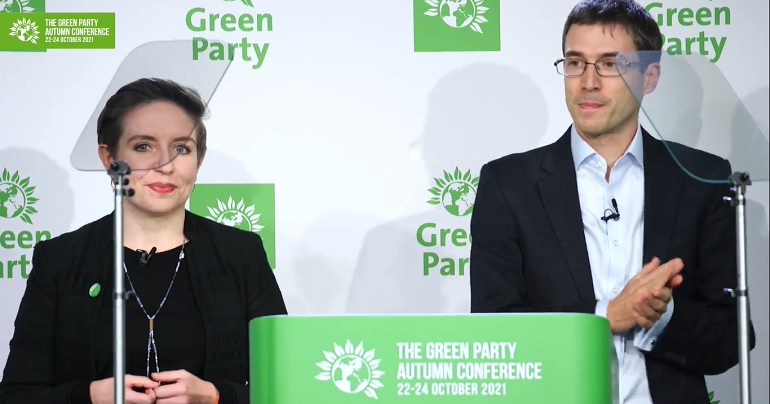Understanding the four different motions on the energy crisis coming to Green Party Conference

Before the Queen died so did our energy system. The Green Party of England and Wales leadership has run ahead of the UK government on this – announcing more far-reaching policy more quickly. The party’s autumn conference will be the first chance for members to have their say. Characteristically, there are 4 possible options before members, each with their own balance of Green values and considerable procedural guff.
Background
When gas prices exploded, the UK government was in a particular spot – with high quantities of gas generation, little gas storage, the cessation of building the cheapest form of energy in onshore wind (raising prices £24 per household), no energy saving programme (raising prices £16 per household) and the decoupling of the UK from the European energy system. The price of energy to run the country is expected to rise from 4% of GDP to 16%.
Meanwhile, the government was also in slow motion collapse.
The opposition parties put forward their plans including the Green Party’s co-leaders, who pushed a number of longstanding party policies that would help the situation: renewables, insulation and universally handing out money. To deal with the onrushing disaster set to plunge 66% of household into fuel poverty, they suggested nationalising the retail energy sector – something suggested days earlier by former Labour Prime Minister Gordon Brown. They combined this with windfall taxes on the fossil fuel sector and landlords. So far, standard Green Party fare, innovative but well established in party policy. The Green Party leadership also supporting capping the price of energy.
What’s is the problem with price caps?
Price controls on energy were recently denounced as Marxism but are now mainstream orthodoxy. However, this is probably new policy for the Green Party. Greens have often played with the idea that energy prices should be higher to push more efficient usage. However, we also have a longstanding commitment to everyone being able to access life’s essentials.
There appears to be little disagreement about most of the leadership position. However, some members oppose the price capping approach, arguing that reducing the price of domestic energy and gas effectively means government subsidies for energy use reduce incentives to to cut energy use and will benefit the richest most as they tend to use more energy.
Why has the Green Party adopted a price capping approach?
Supporters of the price cap approach have argued that capping the price of energy is a solution that can be implemented now. The leadership have indicated that in the long term they would like to work towards a system of differentiated tariffs, but this will take time to work out and the crisis is here and now.
They also point to reports which find that while the richest do use more energy that the poorest on average, due to changing insulation and quality of housing, energy use varies widely among income decimals. This means that benefits to protect one low income household may be insufficient for another in lower quality housing. This suggests that the only approach to protect everyone is to insulate households directly from the cost of energy via subsidies.
What are the other approaches?
There are four motions on this topic coming to conference all of which are slightly different. Table 1 below highlights the key features of the positioned announced by the party’s co-leader Carla Denyer. This is almost identical to the motion proposed by the party’s finance and economy spokesperson Molly Scott Cato, ‘Protecting People from Soaring Energy Prices’.
The next motion is proposed by Martin Farley – former chair of the Green Party tax and fiscal policy working group. He has argued that the party’s approach should be to allow energy prices to rise and prevent people failing into poverty via a flat universal payment known as basic income. To this end, his motion ‘Removing subsidies for fossil fuel consumption from the ‘fairer, greener bills’’ removes the energy price cap from the party’s position and instead argues for a windfall tax with additional welfare payments distributed at a flat rate to everyone. He calculates this will give the lowest income decile £2700 per household, more than offsetting the cost of energy price rise for the average low-income household.
Critics of this approach suggest that the state currently has no ability to make such transfers and it would take time to implement it. They also argue that while this works for the average household, those in poor housing stock could be left exposed. The motion proposer contests that currently the state pays money to a large portion of the population.
The third motion – ‘Ensuring that Sufficient Energy is Affordable to all’ – is intended as a compromise between these two approaches. It is proposed by Jonathan Essex, a member of the Green House think tank and a Councillor in Surrey. From Table 1 it is apparent that this motion has a number of unique elements. It is the only one to commit to nationalisation of the energy sector. On the price cap, it suggests a minimum energy allowance is capped at a low-price level with anything excess charged at market rates. The motion proposers see this as a solution that can be quickly implemented while waiting for a more complex approach of differentiated tariffs. Proposers of other motions see this as too complex to be easily explained, not taking into account energy efficiency rating and possibly less progressive than a universal basic income approach.
The final motion in this group is somewhat different. Proposed by Rosie Rawle, an Oxford City Councillor and local party support coordinator on the Green Party executive, it is called ‘Motion to affiliate to “Enough is Enough”’. Enough is Enough is a coalition formed in response to the cost of living crisis, drawing from prominent voices on the left and prominently supported by trade unions. Carla Denyer, already noted its demands align with Green policy. Indeed table 1 suggests their demands are in many ways slightly less radical than the party’s current position.
Green Party conference would take place on the campaign group’s national day of action on October 1, where protests are planned in 13 cities. Among Enough is Enough’s demands is a call for price capping. This means it is likely to fall into the same argument that the other motions have.
| Current Green position | Protecting People from Soaring Energy Prices | Removing subsidies for fossil fuel consumption from the ‘fairer, greener bills’ campaign | Ensuring that Sufficient Energy is Affordable to all | Motion to affiliate to “Enough is Enough” | UK government position | |
| Proposed by | Green Party co-leaders | Molly Scott Cato | Martin Farley | Jonathan Essex | Rosie Rawle | The cabinet |
| Nationalisation | Yes – retail firm | Yes – retail firms | Yes – ‘Major energy firms’ | Yes – Transmission, distribution and retail | Yes – ‘energy companies’ | No |
| Price cap | Yes – at October 2021 level | Yes – at ‘affordable levels’ | No | Yes – but only for a basic energy allowance | Yes – at March 2022 levels | Yes at October 2022 level |
| Windfall tax | Yes – Close loopholes from Sunak’ windfall tax and on higher earners | Yes – on North Sea backdated to January 2022 and raise taxes on higher earners | Yes – tax on corporate profits and high earners | Yes – on fossil fuel company profits backdated to January 2022 and on North Sea energy producers | Yes – Raising taxes on corporate profits, increasing capital gains tax, introduce taxes on speculation and a wealth tax. | No |
| Cash transfers | Yes – £40 uplift in Universal Credit
£320 boost to fuel payments |
Yes – £40 uplift to Universal Credit and introduction of Universal Basic Income | Yes – flat universal payment key purpose of motion | Yes – £40 uplift in Universal credit and introduction of Universal Basic Income | Yes – £20 a week uplift to Universal Credit plus “inflation-busting” increases to benefits and pensions | Yes – £400 energy support scheme and £1200 to most vulnerable households |
| Home insulation | Yes | Yes | Yes | Yes | Yes | No (this makes UK almost unique in Europe) |
It is worth comparing these motions to what we know of the proposed government response, as table 1 has done. From here it becomes apparent that the party is both relatively united but also far more coherent in its policy position than those running the country. It is also worth noting that almost all of the proposed Green Party approaches would likely cost less.
So what happens at conference?
This remains unclear. Three of the motions were initially ruled out of order by the standing orders committee – the body that oversees conference – as they did not call for a direct action of a body of the Green Party or specify what policy they were changing. Two of these where re-proposed in an amended format, but it seems likely that Molly Scott Cato’s version, ‘Protecting People from Soaring Energy Prices’ will not be put to conference.
It is possible none of the motions will be heard. All have been proposed though a late motions mechanism that is meant to cover responses to events after the normal agenda has closed. While the standing orders committee (SOC) has wide discretion over these, traditionally only the two with the most proposers are heard at conference. Currently only Rosie Rawle’s ‘Motion to affiliate to “Enough is Enough”’ qualifies. Given the unprecedented events that have transpired recently it is possible SOC may show additional discretion.
Whatever motions are heard, those pushing alterative perspectives are likely to bring a flurry of amendments. In many ways this is a sign of a healthy democratic culture within the party. However, the debate on the party’s response to the energy crisis likely to generate most of the heat this conference.
PS. We hope you enjoyed this article. Bright Green has got big plans for the future to publish many more articles like this. You can help make that happen. Please donate to Bright Green now.




Leave a Reply